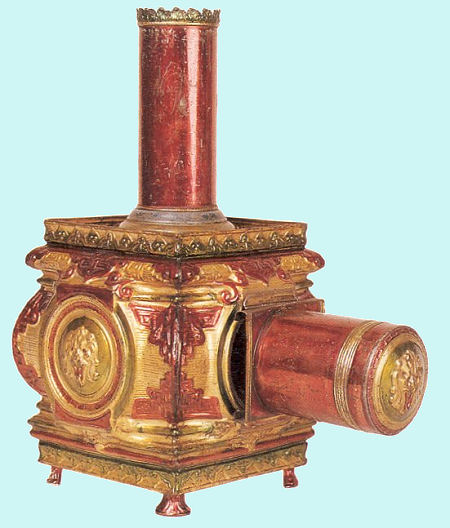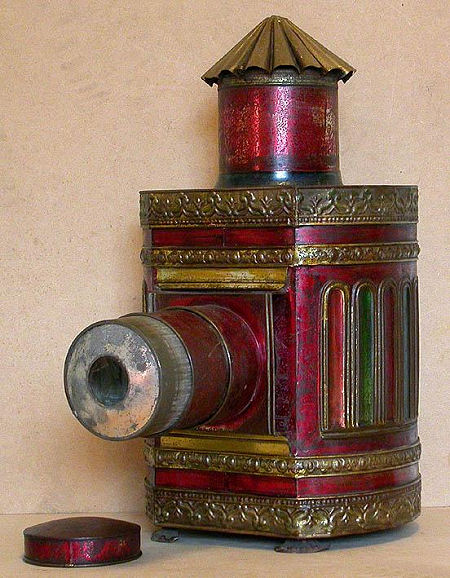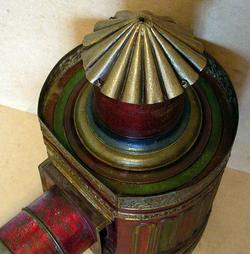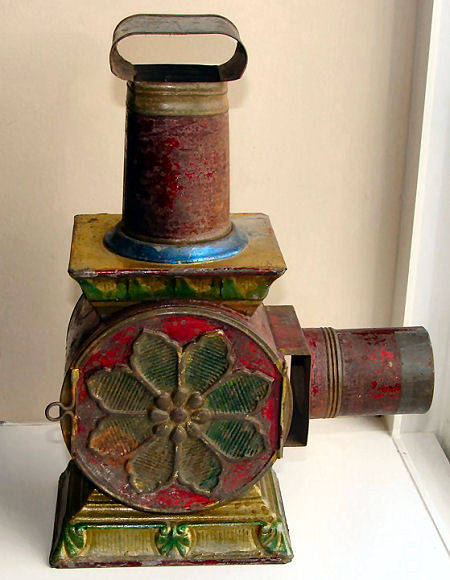 |
||
|
Lampascope Carré, 1880 A lampascope is a magic lantern placed on top of an oil lamp, usually an ordinary household table lamp. Most lampascopes were globular models, like the Boule (see below). Others, like this Carré, are less rounded, embellished, and attractively polychromed in translucent alcohol varnishes. They were fitted with a long cylindrical chimney and a reflector filled with sand at the back to counterbalance the lens.  Reflector. Reflector.The model Carré was sold in six sizes and a lot of designs. |
||
|
|
Lampascope Carré, 1893. Special design mounted on a stand that contains an oil lamp. Lantern and stand are both bronzed. Around 1900 also Carré's made of polished aluminium were produced. Sizes 30 x 20 x 59 cm. |
|
|
Lanterne Carrée,
1880 (double e!) Same design as the small rectangular lantern that was produced by Aubert. Lapierre's lanterns, though less well-finished than those of Aubert, were cheaper and more often sold.  The oldest design is distinguishable by the cylindrical feet (1845). The second design from 1860 has cone-shaped feet and the youngest design has cast, decorated feet, like the one on the photo right. The last mentioned was produced in nine sizes for many years. |
 |
|
 One of the first 'Carrée' lanterns, with cylindrical feet, c. 1845. Only 8" (ca 20 cm) high. |
 One of the last versions of the 'Carrée' lanterns, with profiled feet, c. 1870. This one measures 7 inches (18 cm) front to back and stands 9.5 inches (24 cm) tall. |
|
 |
 |
|
|
At first glance, this lantern looks like an
ordinary Lanterne Carrée by Lapierre. However, it was manufactured in
the 1880s by the son of the company founder Auguste Lapierre, Edouard
Virgile Lapierre under the E.V.L Paris brand. Tin painted with alcohol lacquer. Dimensions 18 x 9.5 x 24 cm. Adjustable lens with lens cap. In sturdy cardboard box of 28 x 25.5 x 10.5 cm. |
||

 |
Lanterne Chinoise, 1880 'Modèle très soigné avec décors de style, livré en carton avec 12 vues en peinture fine sur verre.' (advertisement) Model with stylish decoration, delivered in cardboard box with 12 glass hand painted slides. Made of tin, painted with a red alcohol varnish; the roofs are blue. Transfers with Chinese patterns on both sides. Was available in four sizes, 25, 27, 31 and 36 cm high. |
|
 |
Lampascope Boule, 1880 This Lampascope Boule is designed to fit on top of a domestic oil lamp to use its light. The oldest specimens are translucently lacquered. Overall height is 13 inches, with the body being 7 inches in diameter. |
|

 The Lampascope Boule was later also sold with a bronze lacquer applied to the metal. There is a hole in the bottom for placing the lantern on the top of an house hold oil lamp. |
||
 |

Lampadophore,
1886 |
|
|
A later produced polychrome Lampadophore was able to show images
arranged around a circular glass slide. The Lampadophore was sold in several
sizes. |
||
|
Lanterne Riche, 1880
Polychrome magic lantern made by
Edouard Lapierre around 1884. At this period the company
produced a very popular range of lanterns for children, decorated with a
characteristic transparent coloured lacquer: the Lanterne Salon, the Lanterne Bijou, the
Lanterne Médaillon, the Lampascope Carré, the Lampascope Boule and the Lanterne Riche. |
 |
|
 Photo: ©Pierre Patau, antiquetoysandgames.com. |
||
  Lanterne Bijou, c. 1880 |

 Beautiful decorated French magic lantern, c. 1870. |
|
|
This lantern was made in a bare nickel version, and in a multicoloured tin version,
both only one size. This is the smallest model magic lantern made by Lapierre. The
lantern is placed on a tapering pedestal with a build in oil lamp. Sizes: 18 cm high; 24 cm including pedestal. |
Probably made by Lapierre. A small brass plate above the lens holder reads "Breveté SGDG". The lantern is 12" (32.5 cm) high. | |
 |
Lanterne Salon, 1880
Beautiful magic lantern in original box. Lapierre´s magic lanterns were mostly accompanied by mass-produced slides, printed in outline and subsequently coloured by hand, distinguishable by their green paper binding at the edges. |

 |
|
 Lanterne Salon, boxed with accompanying magic lantern slides. |
 Characterizing French magic lantern sides that could be shown by LaPierre's magic lanterns. |
 |
 Lanterne Cartoscope Episcope for the projection of post cards. |
 Lanterne Medaillon, 1880 Multicoloured lacquered tin. Was produced in 4 sizes. |
 |
 |
 |
 |
 |
|
A kinematograph made by Lapierre that differs greatly
from the characteristic design of almost all other lanterns from this
manufacturer. The film transport takes place by means of a Maltese
cross, the points of which we see protruding besides the sprockets. The
projection lens can be flipped to the side, after which an upward-hinged
mask with a rectangular cut-out can be flipped up when projecting
lantern slides. In addition to the text 'Lapierre - Cinéma', we also find the letters 'UNIS FRANCE' at the Lamphuis. The last text indicated that it was a French product. It was a national label and therefore not a trademark, as we often think *. This cinematograph was probably released shortly before or during the merger with Demaria, after which the company continued as Demaria-Lapierre. |
*
UNIS-FRANCE was an organisation in which a large number of French
companies was united. It was established probably during or shortly
after the First World War in Paris, and existed up to the 1930s. UNIS is
short for 'Union Nationale Inter Syndicale'. Aim was the promotion of
French products, while it was a kind of quality brand too. It can be
considered as a counterbalance for the mention 'Made in Germany'. On this lantern the indication UNIS-FRANCE is placed in a sharp oval near which also some numbers are printed, but also other versions of the logo are known. |
 |
 |
|
Cinematograph "Lapierre Cinema". Model circa 1915.
With a crank for projecting animated images on small flexible 35 mm
films and images onto glass. The lantern came in a burgundy box
containing the lantern, two sets of small glass magic lantern slides and
a 35mm wide celluloid film. |
|
|
|
See also: magic lanterns from Demaria-Lapierre |
| |
©1997-2022 'de Luikerwaal' All rights reserved. Last update: 30-06-2022. |
